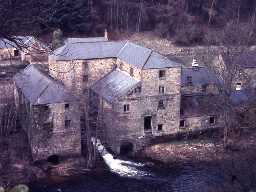Felton Mill (Felton)
(NU 18260006) Felton Mill
(NZ 18199994) Mill Race. (1)
Felton Mill, a large square building of three and four storeys (built into the sloping river bank), with lower additions. Still in use as a grain store. Grade II. The curved dam and mill leat are not listed but recommended by Authy 3 as Grade II. (2)(3)
Water powered corn mill with high and low kilns plus saw mill driven by three undershot water wheels. All machinery is intact. Surveyed at 1:100 scale in 1970s. Drawings include: six external elevations and a section through the mill showing the three wheels and low kiln. (4)
Felton Mill. Grade II listed building. 18th and early 19th century water mill. Interior being remodelled at time of survey, three undershot water wheels in the process of being broken up. (5)
Probably the finest speciment in Northumberland. It was in use until 1970 when the last miller retired after 59 years. The main building is three storeys with an older two storey building at the west end which probably housed the original mill, although it was later used as a joiners shop. It was badly damaged by fire in 1863.
The feature which makes Felton unique is its three waterwheels fed from an adjacent small collecting pond. A separate sluice opens direct to the wheel or wheels to be used. The water supply comes from the Coquet being brought along a leat cut in the natural rock from a fine dam across the river a quarter of a mile upstream.
The corn mill, with four pairs of stones, has an undershot wheel of 16 feet by 4 feet, iron rimmed with eight wood spokes and forty paddles. The second wheel is breast shot and drove an oat mill; it was used until World War II. The wheel is smaller than the corn mill wheel, being 12 feet by 5 feet. Its main functions were to drive two sets of stones, a pearl barley machine and a rotary kiln. There is also a square kiln. The third wheel was once used to work a saw mill. The history of the mill goes back to the 13th century. (6)
The mill last worked in 1970 by miller John Colvill, who had held that role since 1911. The mill wheel and machinery was moved to Beamish Museum when the mill was sold and converted to living accommodation. (7)
Felton Mill, NU 185 003 (index no 46/012). On River Coquet. Three existing wheels as breast-shot wheel. Four pairs of O12/1 type; two pairs of 012/2 type and Sewing 012/3 type. One rotary kiln and one square kiln. Photographed exterion and interior. In working condition [1964-65]. A magnificent group of mill and associated housing. Recorded by Major and Griffith. (8)
Recorded by NRIM, photographed. (9a)
(NZ 18199994) Mill Race. (1)
Felton Mill, a large square building of three and four storeys (built into the sloping river bank), with lower additions. Still in use as a grain store. Grade II. The curved dam and mill leat are not listed but recommended by Authy 3 as Grade II. (2)(3)
Water powered corn mill with high and low kilns plus saw mill driven by three undershot water wheels. All machinery is intact. Surveyed at 1:100 scale in 1970s. Drawings include: six external elevations and a section through the mill showing the three wheels and low kiln. (4)
Felton Mill. Grade II listed building. 18th and early 19th century water mill. Interior being remodelled at time of survey, three undershot water wheels in the process of being broken up. (5)
Probably the finest speciment in Northumberland. It was in use until 1970 when the last miller retired after 59 years. The main building is three storeys with an older two storey building at the west end which probably housed the original mill, although it was later used as a joiners shop. It was badly damaged by fire in 1863.
The feature which makes Felton unique is its three waterwheels fed from an adjacent small collecting pond. A separate sluice opens direct to the wheel or wheels to be used. The water supply comes from the Coquet being brought along a leat cut in the natural rock from a fine dam across the river a quarter of a mile upstream.
The corn mill, with four pairs of stones, has an undershot wheel of 16 feet by 4 feet, iron rimmed with eight wood spokes and forty paddles. The second wheel is breast shot and drove an oat mill; it was used until World War II. The wheel is smaller than the corn mill wheel, being 12 feet by 5 feet. Its main functions were to drive two sets of stones, a pearl barley machine and a rotary kiln. There is also a square kiln. The third wheel was once used to work a saw mill. The history of the mill goes back to the 13th century. (6)
The mill last worked in 1970 by miller John Colvill, who had held that role since 1911. The mill wheel and machinery was moved to Beamish Museum when the mill was sold and converted to living accommodation. (7)
Felton Mill, NU 185 003 (index no 46/012). On River Coquet. Three existing wheels as breast-shot wheel. Four pairs of O12/1 type; two pairs of 012/2 type and Sewing 012/3 type. One rotary kiln and one square kiln. Photographed exterion and interior. In working condition [1964-65]. A magnificent group of mill and associated housing. Recorded by Major and Griffith. (8)
Recorded by NRIM, photographed. (9a)
N4341
DESK BASED ASSESSMENT, National Record of Industrial Monuments ; RCHME
Disclaimer -
Please note that this information has been compiled from a number of different sources. Durham County Council and Northumberland County Council can accept no responsibility for any inaccuracy contained therein. If you wish to use/copy any of the images, please ensure that you read the Copyright information provided.
